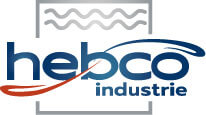ALUMINIUM CORES
HEBCO Industrie
The use of aluminium cores for the manufacture of cooling radiators
Aluminium has become an essential ingredient in the manufacture of radiator cooling cores. Its good thermal conductivity allows it to compete with copper for price, weight and mechanical strength. The plate and bar technology introduced more than 25 years ago makes it possible to manufacture cooling radiators for different fluids and applications. One of the main features of the Plates and Bars brazed is its mechanical resistance which allows to withstand pressures of up to 30 bar. These aluminium cores make it possible to create oil cooling radiators for many industrial applications (compressors, boxes, engine oil, etc.). Despite the terminology used, not all radiators are used for cooling but also often for temperature regulation to optimize the operation of a complex thermal system.
The series of tubes and fins allows to realize a cooling radiator fully configurable in one or several parts, which allows not to be limited in dimensions. The main function of the fins, whose pitch can be adjusted according to the applications, is to amplify the heat transfer. The tube may or may not be equipped with a turbulator or disruptive device that further increases the thermal performance of the cooling radiator while ensuring greater customization.
Read documentation
With the technology of aluminium cores type plates and bars vacuum brazed, you make the choice of quality and flexibility of realization.
The industrial know-how of CATALDI sas and HEBCO makes it possible to propose solutions for all aluminium heat exchanger applications:
Aluminium cores and radiators for industrial applications
- Dry refrigerant
- Traction transformer
- Power Transformer
- Aerotherme
- Heat exchanger
- Oil cooler
- Air exchanger
- Water radiator
- Compressor
Combined cooling elements
The radiator expertise associated with the expertise in the work of aluminium (vacuum brazing, cutting, forming, welding) makes it possible to offer multi-heat exchangers circuits to reduce overall footprint by pooling the cooling of the various water/air/oil circuits.
Technological comparison
Strip and Plates
HEBCO INDUSTRIE TECHNOLOGY
Advanced vacuum brazing
COMPETITIVE TECHNOLOGY
NOCOLOK Brazing
Secondary vacuum
10-5 à 10-6 mbar
Purity of brazed joints
Degassed solder
Easy weldability
Welding TIG/MIG
Reliability
Mechanical resistance and longer
service life
Visual rendering
No cleaning
Finish
Painting not essential


No vacuum
Even relative
Corrosion of brazed joints
Fluxing residues, Gas pockets
Medium weldability
Average quality of the surface finish
Reduced reliability
Premature aging
Shorter service life
Visual rendering
Mandatory cleaning
Finish
Painting essential



